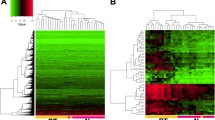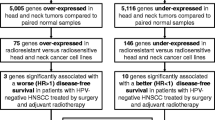Abstract
It is known that head and neck squamous cell carcinomas (HNSCC) originating from different anatomic locations can exhibit varying behavior that is not predictable by histopathology of the primary tumor. Using a microarray containing 27,323 cDNA clones, we generated sets of gene expression profiles for 36 HNSCC primary tumors (12 oral cavity, 12 oropharynx, and 12 larynx/hypopharynx). From these datasets, we ranked genes according to their ability to differentiate between patients whose disease progressed within a 24 month period (aggressive phenotype) and those that did not (non-aggressive phenotype) based on levels of gene expression. A merging of datasets from the three sites revealed that only a fraction of identified genes were shared between any two sites. This contrasted greatly with the significant overlap (approximately 50%) in down-regulated genes identified in tumor/normal comparisons using cases both from oropharynx and larynx/hypopharynx. From these data, we conclude that HNSCC tumors originating from different anatomic sites share consistent changes in gene expression when comparing primary tumors to normal adjacent mucosa; these common changes most likely reflect alterations required for tumor development. In contrast, once a tumor has developed, tumor-host interactions at the different anatomic sites are likely responsible for the site-specific signatures associated with aggressive versus non-aggressive disease. Predictions of outcome based on gene expression profiling are therefore heavily influenced by the anatomic site of the primary tumor.








Similar content being viewed by others
References
Lindberg R. Distribution of cervical lymph node metastases from squamous cell carcinoma of the upper respiratory digestive tracts. Cancer. 1972;29:1446–9. doi :10.1002/1097-0142(197206)29:6<1446::AID-CNCR2820290604>3.0.CO;2-C.
Jemal A, Siegel R, Ward E, et al. Cancer statistics, 2007. CA Cancer J Clin. 2007;57:43–66.
Carvalho AL, Nishimoto IN, Califano JA, Kowalski LP. Trends in incidence and prognosis for head and neck cancer in the United States: a site-specific analysis of the SEER database. Int J Cancer. 2005;114:806–16. doi:10.1002/ijc.20740.
Forestiere AA, Goepfert H, Maor M, et al. Concurrent chemotherapy and radiotherapy for organ preservation in advanced laryngeal cancer. N Engl J Med. 2003;349:2091–8. doi:10.1056/NEJMoa031317.
Koch WM, Lango M, Sewell D, Zahurak M, Sidransky D. Head and neck cancer in nonsmokers: a distinct clinical and molecular entity. Laryngoscope. 1999;109:1544–51. doi:10.1097/00005537-199910000-00002.
Sturgis EM, Wei Q, Spitz MR. Descriptive epidemiology and risk factors for head and neck cancer. Semin Oncol. 2004;31:726–33. doi:10.1053/j.seminoncol.2004.09.013.
Smith EM, Wang D, Kim Y, et al. P16INK4a expression, human papillomavirus, and survival in head and neck cancer. 1. Oral Oncol. 2008;44(2):133–42. doi:10.1016/j.oraloncology.2007.01.010.
Li W, Thompson CH, O’Brien CJ, et al. Human papillomavirus positivity predicts favourable outcome for squamous carcinoma of the tonsil. Int J Cancer. 2003;106(4):553–8. doi:10.1002/ijc.11261.
Forastiere A, Koch W, Trotti A, Sidransky D. Head and neck cancer. N Engl J Med. 2001;345:1890–900. doi:10.1056/NEJMra001375.
Choi P, Chen C. Genetic expression profiles and biologic pathway alterations in head and neck squamous cell carcinoma. Cancer. 2005;104(6):1113–28. doi:10.1002/cncr.21293.
Belbin TJ, Singh B, Smith RV, et al. Molecular profiling of tumor progression in head and neck cancer. Arch Otolaryngol Head Neck Surg. 2005;131:10–8. doi:10.1001/archotol.131.1.10.
Dudoit S. Statistical methods for identifying differentially expressed genes in replicated cDNA microarray experiments. U. C. Berkeley Department of Statistics Technical Report #578. http://www.stat.berkeley.edu/tech-reports/578.ps.Z, 2000.
Eisen MB, Spellman PT, Brown PO, et al. Cluster analysis and display of genome-wide expression patterns. Proc Natl Acad Sci USA. 1998;95:14863–8. doi:10.1073/pnas.95.25.14863.
Leethanakul C, Patel V, Gillespie J, et al. Distinct pattern of expression of differentiation and growth-related genes in squamous cell carcinoma of the head and neck revealed by the use of laser capture microdissection and cDNA arrays. Oncogene. 2000;19:3220–4. doi:10.1038/sj.onc.1203703.
Villaret DB, Wang T, Dillon D, et al. Identification of genes overexpressed in head and neck squamous cell carcinoma using a combination of complementary DNA subtraction and microarray analysis. Laryngoscope. 2000;110:374–81. doi:10.1097/00005537-200003000-00008.
Mukherji SK, Schmalfuss IM, Castelijns J, et al. Clinical applications of tumor volume measurements for predicting outcome in patients with squamous cell carcinoma of the upper aerodigestive tract. Am J Neuroradiol. 2004;25:1425–32.
Ye H, Yu T, Temam S, et al. Transcriptomic dissection of tongue squamous cell carcinoma. BMC Genomics. 2008;9:69. doi:10.1186/1471-2164-9-69.
Lin TS, Chiou SH, Wang LS, et al. Expression spectra of matrix metalloproteinases in metastatic non-small cell lung cancer. Oncol Rep. 2004;12:717–23.
Aung PP, Oue N, Mitani Y, et al. Systematic search for gastric cancer-specific genes based on SAGE data: melanoma inhibitory activity and matrix metalloproteinase-10 are novel prognostic factors in patients with gastric cancer. Oncogene. 2006;25:2546–57. doi:10.1038/sj.onc.1209279.
Wissmann C, Wild PJ, Kaiser S, et al. WIF1, a component of the Wnt pathway, is down-regulated in prostate, breast, lung, and bladder cancer. J Pathol. 2003;201:204–12. doi:10.1002/path.1449.
Chan SL, Cui Y, van Hasselt A, et al. The tumor suppressor Wnt inhibitory factor 1 is frequently methylated in nasopharyngeal and esophageal carcinomas. Lab Invest. 2007;87:644–50. doi:10.1038/labinvest.3700547.
Chen C, Brabham WW, Stultz BG, et al. Defining a common region of deletion at 13q21 in human cancers. Genes Chromosomes Cancer. 2001;31:333–44. doi:10.1002/gcc.1152.
Acknowledgments
The authors would like to thank Aldo Massimi and the Albert Einstein College of Medicine Microarray Facility for their assistance. This study was supported by a grant from the US National Cancer Institute, CA104402 (to TJB).
Author information
Authors and Affiliations
Corresponding author
Rights and permissions
About this article
Cite this article
Belbin, T.J., Schlecht, N.F., Smith, R.V. et al. Site-Specific Molecular Signatures Predict Aggressive Disease in HNSCC. Head and Neck Pathol 2, 243–256 (2008). https://doi.org/10.1007/s12105-008-0071-4
Received:
Accepted:
Published:
Issue Date:
DOI: https://doi.org/10.1007/s12105-008-0071-4




